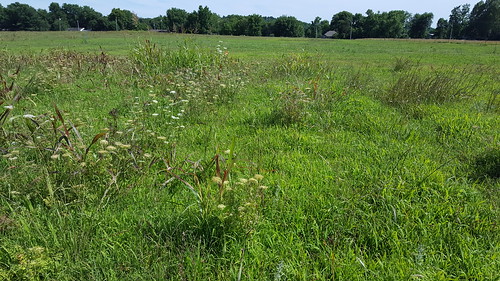Making the most out of Johnsongrass
June 28, 2019
By Abbi Ross
U of A System Division of Agriculture
@AgNews479
Fast Facts:
- Johnsongrass can release prussic acid when under stress
- Cows will graze on Johnsongrass heavily
- Horses should not graze on Johnsongrass
(363 words)
(Newsrooms: with art at https://flic.kr/p/2gm3QUm )
Download Word version
FAYETTEVILLE, Ark. — Livestock producers have a love-hate relationship with Johnsongrass, which can be helpful or harmful, depending on the situation, said Dirk Philipp, associate professor-animal science for the University of Arkansas System Division of Agriculture.
It can be very persistent, and has thick rhizomes that enable it to not only survive long-term, but also to spread easily, said Dirk Philipp, an associate professor for the animal science department.
On the one hand, “Johnsongrass is devoured by cattle, they go for it no matter how seemingly nutritious the rest of the pasture appears,” Philipp said.

However, Johnsongrass has a nasty habit. When stressed by drought, frost, or other factors, it produces prussic acid, which can be toxic to livestock at high rates. Horses are less susceptible to prussic acid than ruminants, but low exposure over time can create separate health issues. Equines should not graze on sorghum-type forages, including Johnsongrass.
On the plus side, Johnsongrass greens up along with bermudagrass, providing warm-season grazing. If a rancher is grazing livestock on a pasture with Johnsongrass along with a base forage such as tall fescue and bermudagrass, it’s important to pay attention to the Johnson grass growth stage. Fresh, young re-growth, or stressed, dry Johnsongrass leaves may have toxic levels of prussic acid. Johnsongrass plants should be 18 inches tall before grazing begins.
“When in doubt, make sure cattle have access to other forage or roughage. If there are only moderate amounts of Johnsongrass available, toxic effects on cattle are unlikely,” Philipp said, adding that “Johnsongrass is also great for haying as the prussic acid concentrations, if any, declines substantially during hay storage.”
For livestock owners who want to get rid of Johnsongrass, there are multiple methods including:
- Spraying with a recommended herbicide when the grass gets about 12 inches high. However, this can be costly – up to $40 an acre – if the grower wants to keep the base forage.
- “Wiping” Johnsongrass with glyphosate products, but this requires special equipment.
- Grazing repeatedly with cattle to defoliate the plants will drastically reduce Johnsongrass occurrence.
Additionally, Philipp said “if you have horses and want to sue the same paddock, let cattle graze first to reduce exposure to Johnsongrass.”
To learn more about Division of Agriculture research, visit the Arkansas Agricultural Experiment Station website. Follow us on Twitter at @ArkAgResearch and Instagram at ArkAgResearch.
About the Division of Agriculture
The University of Arkansas System Division of Agriculture’s mission is to strengthen agriculture, communities, and families by connecting trusted research to the adoption of best practices. Through the Agricultural Experiment Station and the Cooperative Extension Service, the Division of Agriculture conducts research and extension work within the nation’s historic land grant education system.
The Division of Agriculture is one of 20 entities within the University of Arkansas System. It has offices in all 75 counties in Arkansas and faculty on five system campuses.
Pursuant to 7 CFR § 15.3, the University of Arkansas System Division of Agriculture offers all its Extension and Research programs and services (including employment) without regard to race, color, sex, national origin, religion, age, disability, marital or veteran status, genetic information, sexual preference, pregnancy or any other legally protected status, and is an equal opportunity institution.
# # #
Media Contact: Mary Hightower
Dir. of Communication Services
U of A System Division of Agriculture
Cooperative Extension Service
(501) 671-2126
mhightower@uada.edu
Related Links